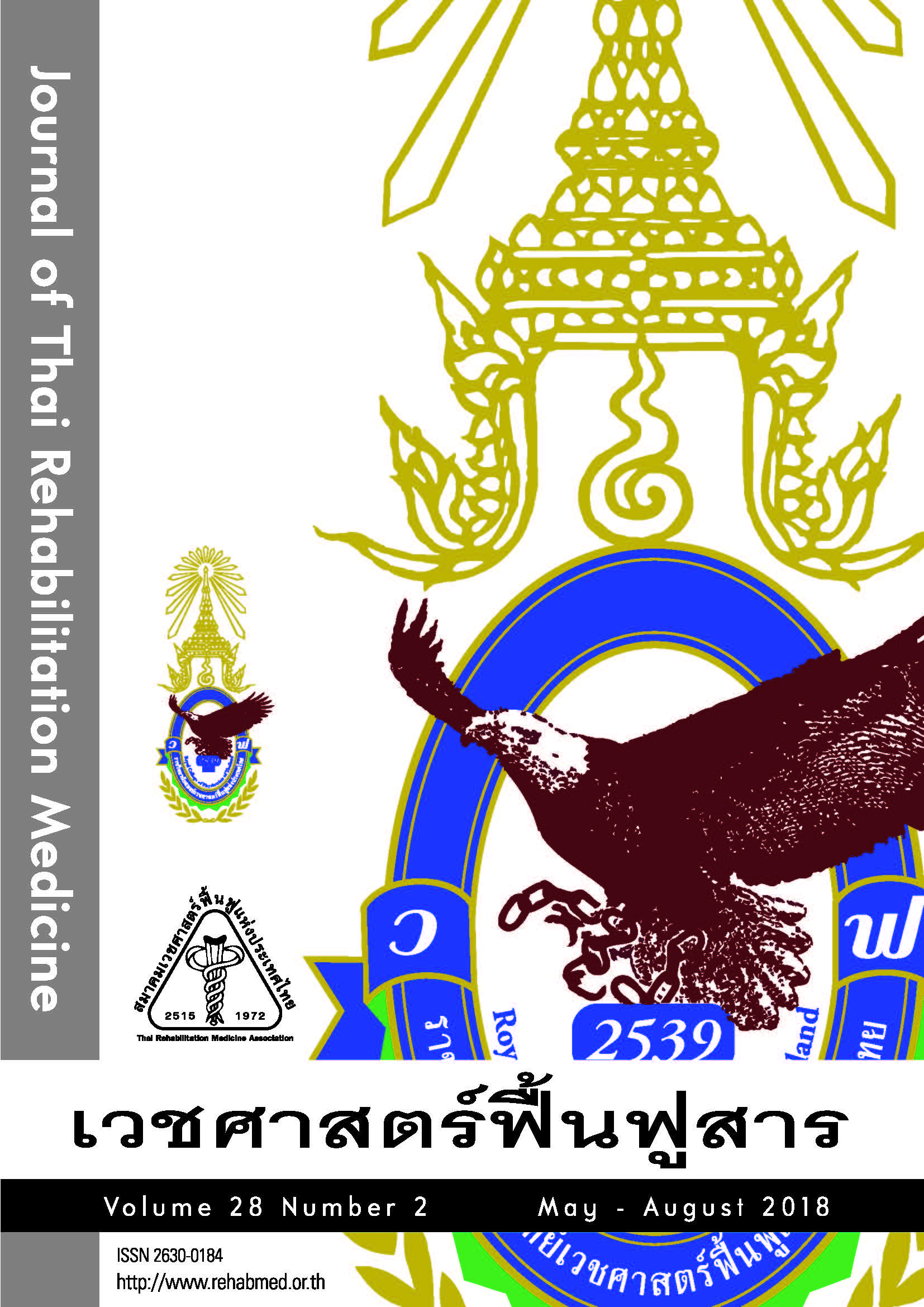The Prevalence of Oropharyngeal Dysphagia in Acute Stroke Patients at Srinagarind Hospital
ความชุกของภาวะกลืนลำบากระดับช่องปากและลำคอในผู้ป่วยโรคหลอดเลือดสมองระยะเฉียบพลันที่โรงพยาบาลศรีนครินทร์
Keywords:
ภาวะกลืนลำบาก, โรคหลอดเลือดสมองระยะเฉียบพลัน, การคัดกรองภาวะกลืนลำบาก, การทดสอบกลืนน้ำAbstract
วัตถุประสงค์: ศึกษาความชุกของภาวะกลืนลำบากระดับช่องปากและลำคอในผู้ป่วยโรคหลอดเลือดสมองระยะเฉียบพลัน
รูปแบบการวิจัย: การศึกษาแบบพรรณนาไปข้างหน้า
สถานที่ทำการวิจัย: หอผู้ป่วยโรคหลอดเลือดสมองและหอผู้ป่วยเวชศาสตร์ฟื้นฟู โรงพยาบาลศรีนครินทร์
กลุ่มประชากร: ผู้ป่วยโรคหลอดเลือดสมองระยะเฉียบพลัน
วิธีการศึกษา: ผู้ป่วยโรคหลอดเลือดสมองระยะเฉียบพลันทั้งหมดได้รับการคัดกรอง บันทึกข้อมูลพื้นฐาน และข้อมูลเกี่ยวกับชนิดตำแหน่งและความรุนแรงของโรค และการรักษาที่ได้รับประเมินการกลืนด้วยแบบประเมินความเสี่ยงต่อการสำลัก (dysphagia risk screening test) และ modified water swallowing test (MWST) ด้วยการกลืนน้ำ 3 มิลลิลิตร 3 ครั้ง หากได้คะแนน MWST 1-3 แปลว่ามีภาวะกลืนลำบาก และผู้ป่วยทุกรายที่สงสัยว่ามีภาวะกลืนลำบากได้รับการตรวจภาพถ่ายทางรังสีขณะกลืน (VFSS) เพื่อดูการสำลัก
ผลการศึกษา: ผู้ป่วยโรคหลอดเลือดสมอง 102 ราย ได้รับการตรวจประเมิน มีเพียง 59 ราย (ชาย 37 ราย หญิง 22 ราย) ที่มีคุณสมบัติตามเกณฑ์ โดยมีอายุเฉลี่ย 62.7±12.8 ปี ร้อยละ 81.4 ได้รับการวินิจฉัยเป็นสมองขาดเลือด ตำแหน่งที่พบบ่อยคือ subcortical area พบร้อยละ 61 จากแบบประเมินความเสี่ยงต่อการสำลักพบ ร้อยละ 47.5 มีปัญหาพูดไม่ชัด, ร้อยละ 40 มีปฏิกิริยาการขย้อนลดลง, ร้อยละ 30.5 ไอค่อย, ร้อยละ 20.3 มีปฏิกิริยาการกลืนน้ำลายลดลง และมีผู้ป่วยเพียง 2 ราย (ร้อยละ 3) ที่มีภาวะกลืนลำบากและสำลัก
สรุป: ผู้ป่วยโรคหลอดเลือดสมองระยะเฉียบพลันที่มีความรุนแรงน้อย มีภาวะกลืนลำบากในระดับช่องปากและลำคอเพียงร้อยละ 3 เมื่อประเมินด้วยการกลืนน้ำ 3 มิลลิลิตร 3 ครั้ง และยืนยันด้วยภาพถ่ายทางรังสีขณะกลืน
References
2. Smithard DG, O’Neill PA, England RE, Park CL, Wyatt R, Martin DF, et al. The natural history of dysphagia following a stroke. Dysphagia. 1997;12:188–93.
3. Mann G, Hankey GJ, Cameron D. Swallowing function after stroke prognosis and prognostic factors at 6 months. Strroke 1999;30: 744–8.
4. Martino R, Foley N, Bhogal S, Diamant N, Speechley M, Teasell R. Dysphagia after stroke incidence, diagnosis, and pulmonary complications. Stroke. 2005;36:2756–63.
5. Barer DH. The natural history and functional consequences of dysphagia after hemispheric stroke. J Neurol Neurosurg Psychiatr. 1989;52:236–41.
6. Daniels SK, Brailey K, Priestly DH, Herrington LR, Weisberg LA, Foundas AL. Aspiration in patients with acute stroke. Arch Phys Med Rehabil. 1998;79:14–9.
7. Perry L, Love CP. Screening for dysphagia and aspiration in acute stroke: a systematic review. Dysphagia. 2001;16:7–18.
8. Warms T, Richards J. “Wet Voice” as a predictor of penetration and aspiration in oropharyngeal dysphagia. Dysphagia. 2000;15:84–8.
9. Martino R, Pron G, Diamant N. Screening for oropharyngeal dysphagia in stroke: insufficient evidence for guidelines. Dysphagia. 2000;15:19–30.
10. Tohara H, Saitoh E, Mays KA, Kuhlemeier K, Palmer JB. Three tests for predicting aspiration without videofluorography. Dysphagia. 2003;18:126–34.
11. Martin-Harris B, Logemann JA, McMahon S, Schleicher M, Sandidge J. Clinical utility of the modified barium swallow. Dysphagia. 2000;15:136–41.
12. Mann G, Hankey GJ, Cameron D. Swallowing disorders following acute stroke: prevalence and diagnostic accuracy. Cerebrovasc Dis. 2000;10:380–6.
13. Palmer JB, Kuhlemeier KV, Tippett DC, Lynch C. A protocol for the videofluorographic swallowing study. Dysphagia. 1993;8:209–14.
14. Shoji H, Yamamoto T, Inoue T, Oikawa C, Adachi N, Shintani S, et al. Creating flowcharts of eating and swallowing. J Japanese Assoc Rural Med. 2010;58:526-32.
15. Crary MA, Mann GDC, Groher ME. Initial psychometric assessment of a functional oral intake scale for dysphagia in stroke patients. Arch Phys Med Rehabil. 2005;86:1516–20.
16. Osawa A, Maeshima S, Tanahashi N. Water-swallowing test: screening for aspiration in stroke patients. Cerebrovasc Dis. 2013; 35:276–81.






